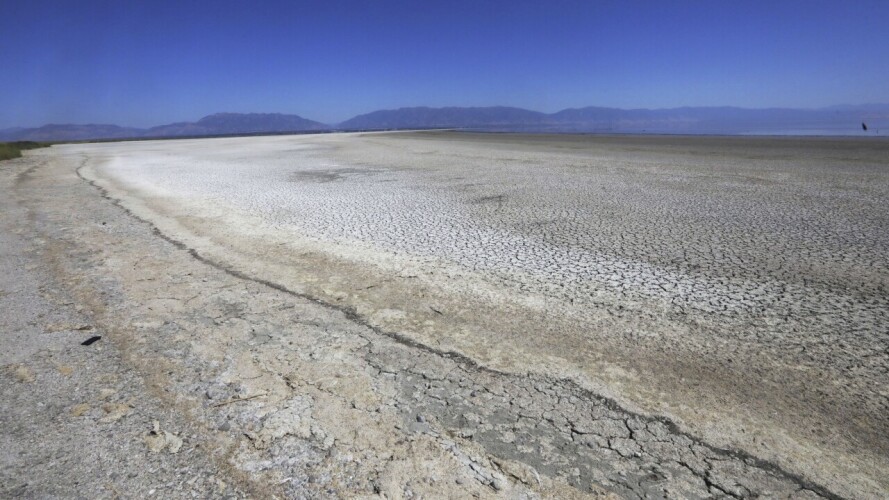SALT LAKE CITY — House Speaker Mike Schultz wants to put the Great Salt Lake on the agenda during an upcoming special session of the Utah State Legislature.
During an interview with members of the Great Salt Lake Collaborative (of which FOX 13 News is a member), Speaker Schultz, R-Hooper, announced a break from his "pause" on major water issues.
"Yes, I think now let’s look at it," he said Thursday. "We’ve got this berm management plan that we’re looking at for sure. We’ve got the new distribution plan. Those are all things we passed that we know are working now let’s look at additional options, absolutely."
Specifically, Speaker Schultz wants to authorize Utah's Division of Forestry, Fire & State Lands to raise the Great Salt Lake Causeway berm — which separates the north and south arms of the lake — to 4,192 feet. That's two feet higher than it is now. That could temporarily cut off the north and south arms of the lake, which have been managed jointly lately (and has led to lower lake levels). But Speaker Schultz argued that doing so helps prop up the south arm, where most of the population lives, and protects against ecosystem collapse.
Reacting to the idea of raising the berm level, Lynn de Freitas with the environmental group Friends of Great Salt Lake, told FOX 13 News that it is probably a good idea.
"It’s a good recognition we still have a lot of work as far as maintaining what we need to do for the south arm where we have this greater ecological viability, where we still have north arm resource potential," she said.
The special session will have to be called by Governor Spencer Cox. It is expected to include a number of legislative agenda items and will likely happen this fall.
FOX 13 News first reported on Tuesday that the Great Salt Lake dropped to 4,192 feet in elevation, triggering mandatory conservation measures under new laws passed by the Utah legislature. Mineral extraction companies are no longer allowed to take as much water from the lake, agriculture producers have already seen cuts to the amount of water they can take. But local water districts have been alarmed by a surge in residential outdoor water use — a contrast to years of diligent conservation.
The lake has dropped dramatically in recent years as a result of water diversions and impacts from drought and climate change. It presents a significant public health threat in the form of toxic dust storms from an exposed lake bed (arsenic is among the naturally occurring minerals), reduced snowpack that feeds into Utah's drinking water supply and billions in economic harm. Millions of migratory birds and other wildlife also rely on the Great Salt Lake as a refuge.
In response, Utah political leaders rushed to pass dozens of bills and spend more than $1 billion on water conservation measures, designed to help the lake. In 2024, Speaker Schultz announced a "pause" on Great Salt Lake legislation to evaluate what was working and what wasn't. That aggravated environmental groups who argued that political leaders were not reacting with the urgency the Great Salt Lake crisis demands.
Public opinion surveys have shown the Great Salt Lake remains a major concern of Utahns.
Speaker Schultz defended his decision to evaluate water legislation that lawmakers had passed, and insisted to reporters with the Great Salt Lake Collaborative that he remains committed to saving the lake.
"None of us want to see the lake gone," he said.
Late Thursday, the Utah State Engineer announced a new management plan for water distribution to the Great Salt Lake that includes priority schedules for mineral extraction water diversions based on lake levels. It also creates a new tool to better track if water that is conserved is actually making it to the lake.
That's been a critical issue for state officials. People have conserved and even dedicated water to the Great Salt Lake — but until recently, the state engineer's office simply hasn't had the data to know if it was making it there.
Utah State Engineer Teresa Wilhelmsen told FOX 13 News that about 160,000 acre feet of water has now been tracked that is making it to the lake. As more water is saved and tracked, that information will now be made public for anyone to see at waterrights.Utah.gov.
"The general public will be able to see the water that has been committed or is actually making it through the lake and track that throughout the year," Wilhelmsen said.
This article is published through the Great Salt Lake Collaborative, a solutions journalism initiative that partners news, education and media organizations to help inform people about the plight of the Great Salt Lake—and what can be done to make a difference before it is too late. Read all of our stories at greatsaltlakenews.org.




